The Importance of Exercise in Cancer Management
VerifiedAdded on 2023/04/21
|10
|2544
|66
AI Summary
This essay discusses the importance of exercise in managing cancer, including its impact on physical and psychosocial dimensions of cancer-related fatigue. It explores various studies and interventions that highlight the benefits of exercise for cancer survivors and patients.
Contribute Materials
Your contribution can guide someone’s learning journey. Share your
documents today.

Running head: ESSAY RESPONSE 1
Essay Response
Institution
Student
Date
Essay Response
Institution
Student
Date
Secure Best Marks with AI Grader
Need help grading? Try our AI Grader for instant feedback on your assignments.
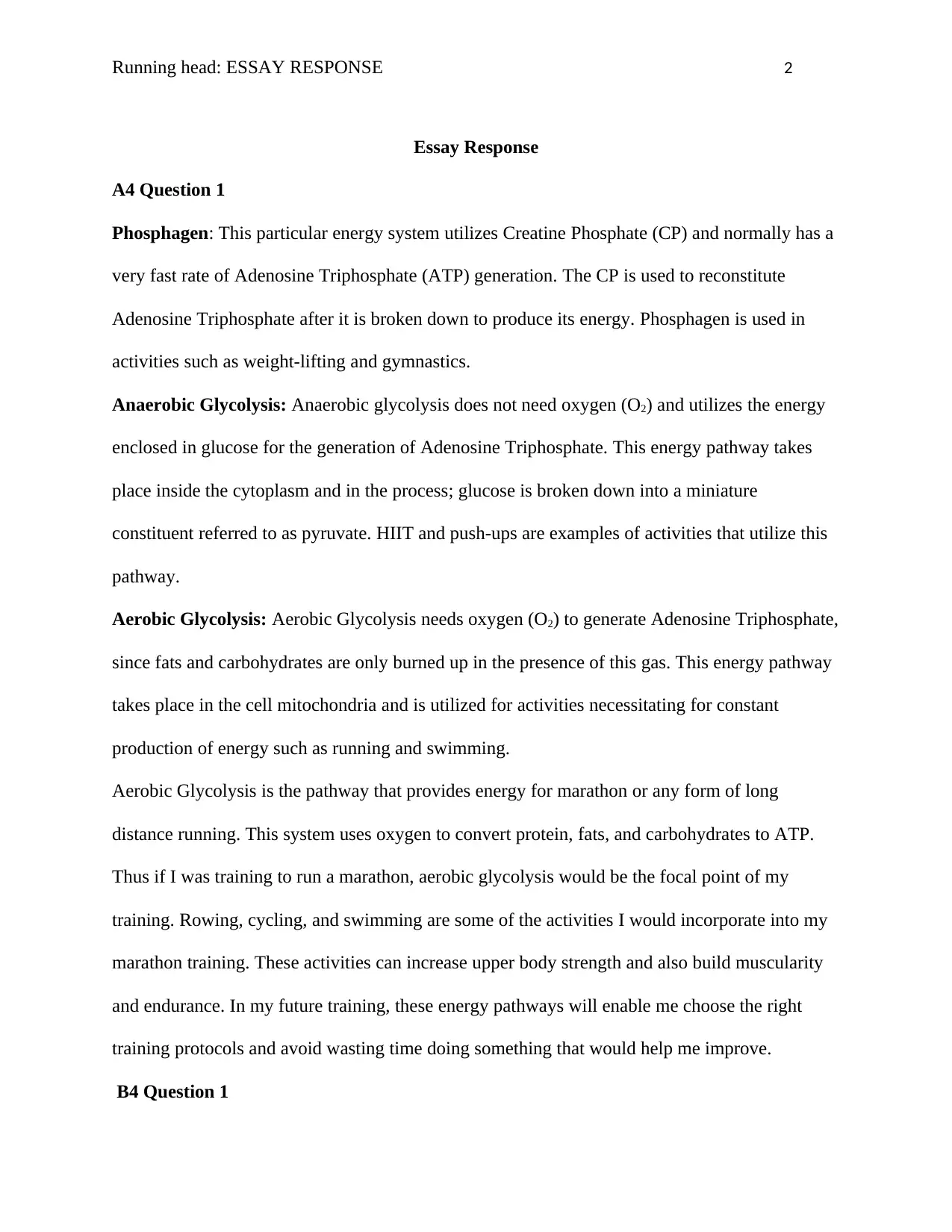
Running head: ESSAY RESPONSE 2
Essay Response
A4 Question 1
Phosphagen: This particular energy system utilizes Creatine Phosphate (CP) and normally has a
very fast rate of Adenosine Triphosphate (ATP) generation. The CP is used to reconstitute
Adenosine Triphosphate after it is broken down to produce its energy. Phosphagen is used in
activities such as weight-lifting and gymnastics.
Anaerobic Glycolysis: Anaerobic glycolysis does not need oxygen (O2) and utilizes the energy
enclosed in glucose for the generation of Adenosine Triphosphate. This energy pathway takes
place inside the cytoplasm and in the process; glucose is broken down into a miniature
constituent referred to as pyruvate. HIIT and push-ups are examples of activities that utilize this
pathway.
Aerobic Glycolysis: Aerobic Glycolysis needs oxygen (O2) to generate Adenosine Triphosphate,
since fats and carbohydrates are only burned up in the presence of this gas. This energy pathway
takes place in the cell mitochondria and is utilized for activities necessitating for constant
production of energy such as running and swimming.
Aerobic Glycolysis is the pathway that provides energy for marathon or any form of long
distance running. This system uses oxygen to convert protein, fats, and carbohydrates to ATP.
Thus if I was training to run a marathon, aerobic glycolysis would be the focal point of my
training. Rowing, cycling, and swimming are some of the activities I would incorporate into my
marathon training. These activities can increase upper body strength and also build muscularity
and endurance. In my future training, these energy pathways will enable me choose the right
training protocols and avoid wasting time doing something that would help me improve.
B4 Question 1
Essay Response
A4 Question 1
Phosphagen: This particular energy system utilizes Creatine Phosphate (CP) and normally has a
very fast rate of Adenosine Triphosphate (ATP) generation. The CP is used to reconstitute
Adenosine Triphosphate after it is broken down to produce its energy. Phosphagen is used in
activities such as weight-lifting and gymnastics.
Anaerobic Glycolysis: Anaerobic glycolysis does not need oxygen (O2) and utilizes the energy
enclosed in glucose for the generation of Adenosine Triphosphate. This energy pathway takes
place inside the cytoplasm and in the process; glucose is broken down into a miniature
constituent referred to as pyruvate. HIIT and push-ups are examples of activities that utilize this
pathway.
Aerobic Glycolysis: Aerobic Glycolysis needs oxygen (O2) to generate Adenosine Triphosphate,
since fats and carbohydrates are only burned up in the presence of this gas. This energy pathway
takes place in the cell mitochondria and is utilized for activities necessitating for constant
production of energy such as running and swimming.
Aerobic Glycolysis is the pathway that provides energy for marathon or any form of long
distance running. This system uses oxygen to convert protein, fats, and carbohydrates to ATP.
Thus if I was training to run a marathon, aerobic glycolysis would be the focal point of my
training. Rowing, cycling, and swimming are some of the activities I would incorporate into my
marathon training. These activities can increase upper body strength and also build muscularity
and endurance. In my future training, these energy pathways will enable me choose the right
training protocols and avoid wasting time doing something that would help me improve.
B4 Question 1
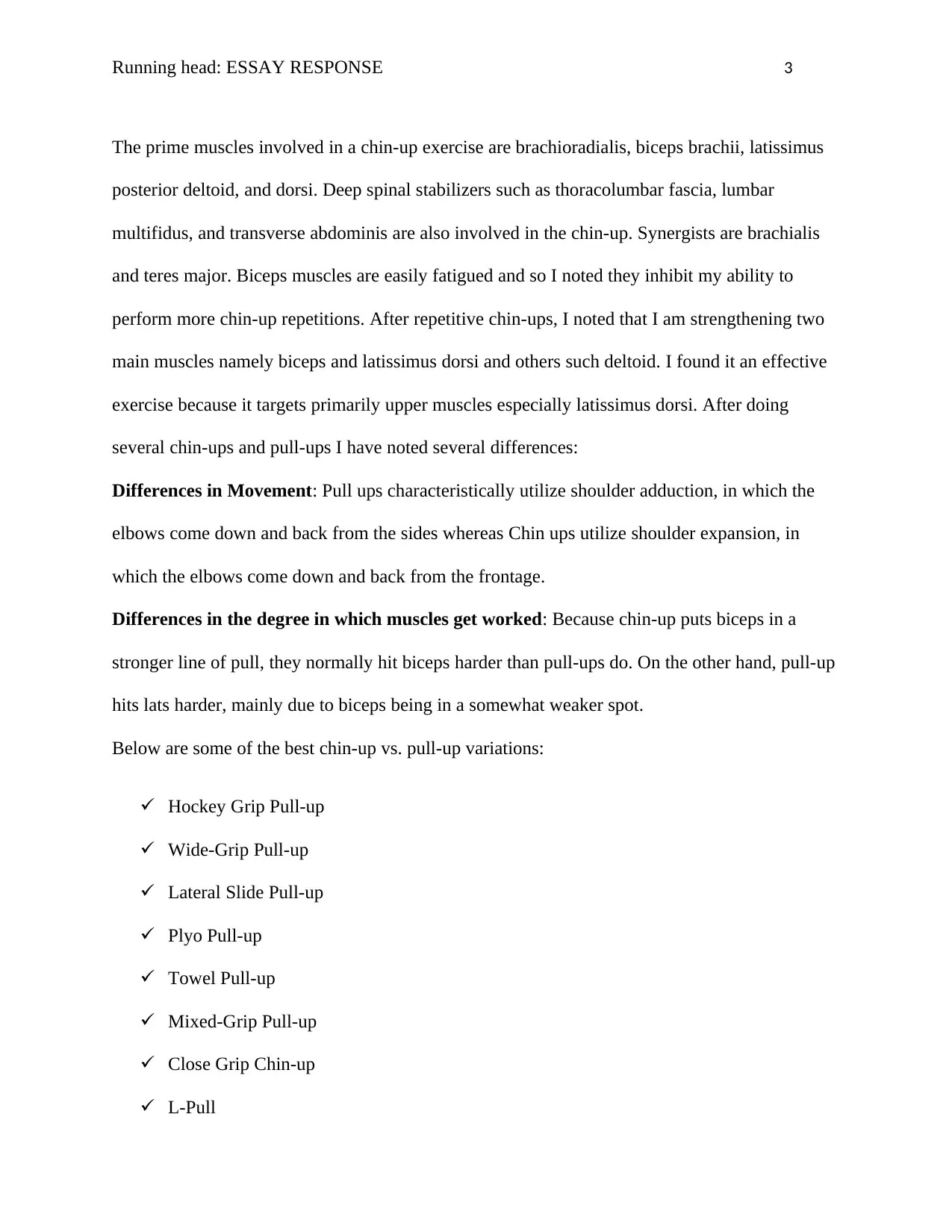
Running head: ESSAY RESPONSE 3
The prime muscles involved in a chin-up exercise are brachioradialis, biceps brachii, latissimus
posterior deltoid, and dorsi. Deep spinal stabilizers such as thoracolumbar fascia, lumbar
multifidus, and transverse abdominis are also involved in the chin-up. Synergists are brachialis
and teres major. Biceps muscles are easily fatigued and so I noted they inhibit my ability to
perform more chin-up repetitions. After repetitive chin-ups, I noted that I am strengthening two
main muscles namely biceps and latissimus dorsi and others such deltoid. I found it an effective
exercise because it targets primarily upper muscles especially latissimus dorsi. After doing
several chin-ups and pull-ups I have noted several differences:
Differences in Movement: Pull ups characteristically utilize shoulder adduction, in which the
elbows come down and back from the sides whereas Chin ups utilize shoulder expansion, in
which the elbows come down and back from the frontage.
Differences in the degree in which muscles get worked: Because chin-up puts biceps in a
stronger line of pull, they normally hit biceps harder than pull-ups do. On the other hand, pull-up
hits lats harder, mainly due to biceps being in a somewhat weaker spot.
Below are some of the best chin-up vs. pull-up variations:
Hockey Grip Pull-up
Wide-Grip Pull-up
Lateral Slide Pull-up
Plyo Pull-up
Towel Pull-up
Mixed-Grip Pull-up
Close Grip Chin-up
L-Pull
The prime muscles involved in a chin-up exercise are brachioradialis, biceps brachii, latissimus
posterior deltoid, and dorsi. Deep spinal stabilizers such as thoracolumbar fascia, lumbar
multifidus, and transverse abdominis are also involved in the chin-up. Synergists are brachialis
and teres major. Biceps muscles are easily fatigued and so I noted they inhibit my ability to
perform more chin-up repetitions. After repetitive chin-ups, I noted that I am strengthening two
main muscles namely biceps and latissimus dorsi and others such deltoid. I found it an effective
exercise because it targets primarily upper muscles especially latissimus dorsi. After doing
several chin-ups and pull-ups I have noted several differences:
Differences in Movement: Pull ups characteristically utilize shoulder adduction, in which the
elbows come down and back from the sides whereas Chin ups utilize shoulder expansion, in
which the elbows come down and back from the frontage.
Differences in the degree in which muscles get worked: Because chin-up puts biceps in a
stronger line of pull, they normally hit biceps harder than pull-ups do. On the other hand, pull-up
hits lats harder, mainly due to biceps being in a somewhat weaker spot.
Below are some of the best chin-up vs. pull-up variations:
Hockey Grip Pull-up
Wide-Grip Pull-up
Lateral Slide Pull-up
Plyo Pull-up
Towel Pull-up
Mixed-Grip Pull-up
Close Grip Chin-up
L-Pull
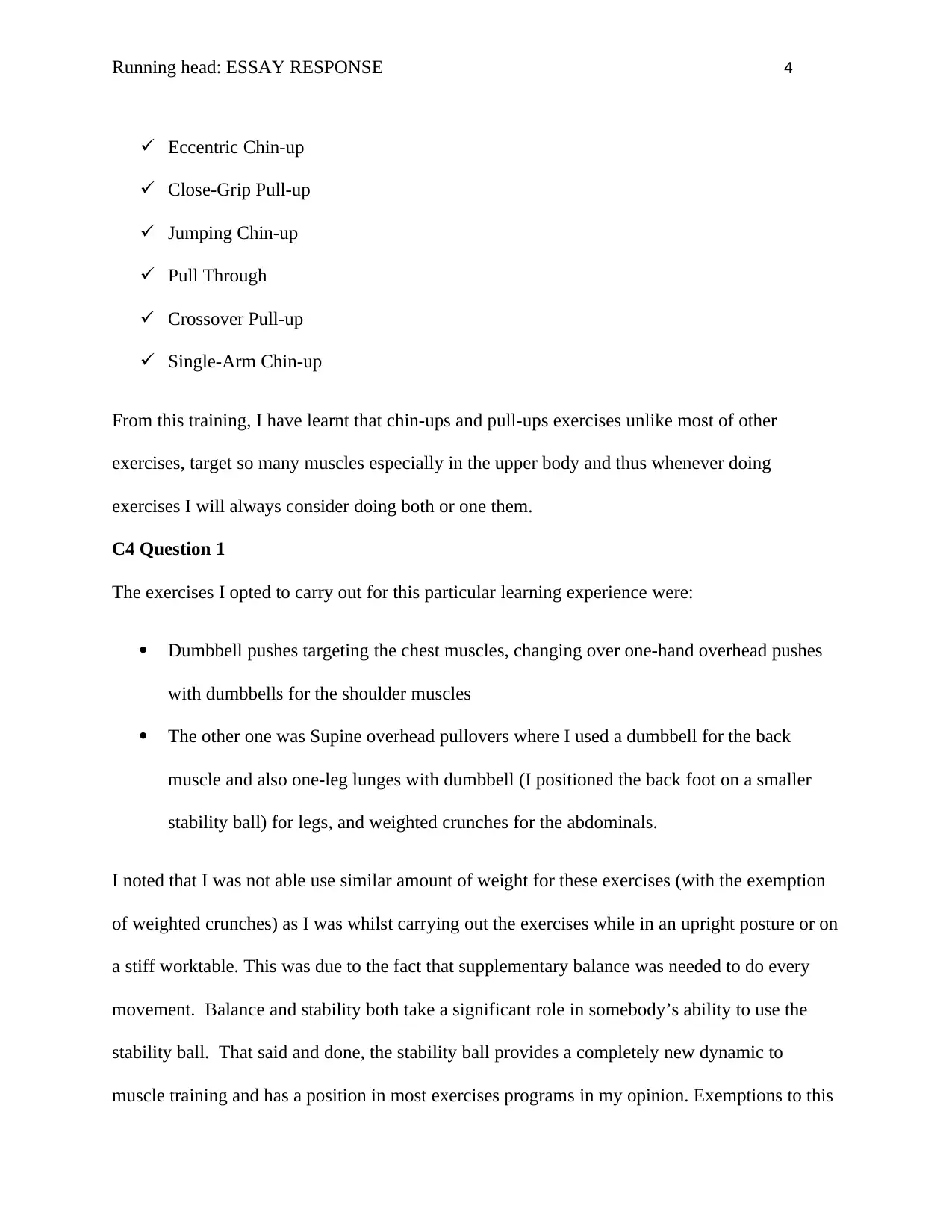
Running head: ESSAY RESPONSE 4
Eccentric Chin-up
Close-Grip Pull-up
Jumping Chin-up
Pull Through
Crossover Pull-up
Single-Arm Chin-up
From this training, I have learnt that chin-ups and pull-ups exercises unlike most of other
exercises, target so many muscles especially in the upper body and thus whenever doing
exercises I will always consider doing both or one them.
C4 Question 1
The exercises I opted to carry out for this particular learning experience were:
Dumbbell pushes targeting the chest muscles, changing over one-hand overhead pushes
with dumbbells for the shoulder muscles
The other one was Supine overhead pullovers where I used a dumbbell for the back
muscle and also one-leg lunges with dumbbell (I positioned the back foot on a smaller
stability ball) for legs, and weighted crunches for the abdominals.
I noted that I was not able use similar amount of weight for these exercises (with the exemption
of weighted crunches) as I was whilst carrying out the exercises while in an upright posture or on
a stiff worktable. This was due to the fact that supplementary balance was needed to do every
movement. Balance and stability both take a significant role in somebody’s ability to use the
stability ball. That said and done, the stability ball provides a completely new dynamic to
muscle training and has a position in most exercises programs in my opinion. Exemptions to this
Eccentric Chin-up
Close-Grip Pull-up
Jumping Chin-up
Pull Through
Crossover Pull-up
Single-Arm Chin-up
From this training, I have learnt that chin-ups and pull-ups exercises unlike most of other
exercises, target so many muscles especially in the upper body and thus whenever doing
exercises I will always consider doing both or one them.
C4 Question 1
The exercises I opted to carry out for this particular learning experience were:
Dumbbell pushes targeting the chest muscles, changing over one-hand overhead pushes
with dumbbells for the shoulder muscles
The other one was Supine overhead pullovers where I used a dumbbell for the back
muscle and also one-leg lunges with dumbbell (I positioned the back foot on a smaller
stability ball) for legs, and weighted crunches for the abdominals.
I noted that I was not able use similar amount of weight for these exercises (with the exemption
of weighted crunches) as I was whilst carrying out the exercises while in an upright posture or on
a stiff worktable. This was due to the fact that supplementary balance was needed to do every
movement. Balance and stability both take a significant role in somebody’s ability to use the
stability ball. That said and done, the stability ball provides a completely new dynamic to
muscle training and has a position in most exercises programs in my opinion. Exemptions to this
Secure Best Marks with AI Grader
Need help grading? Try our AI Grader for instant feedback on your assignments.
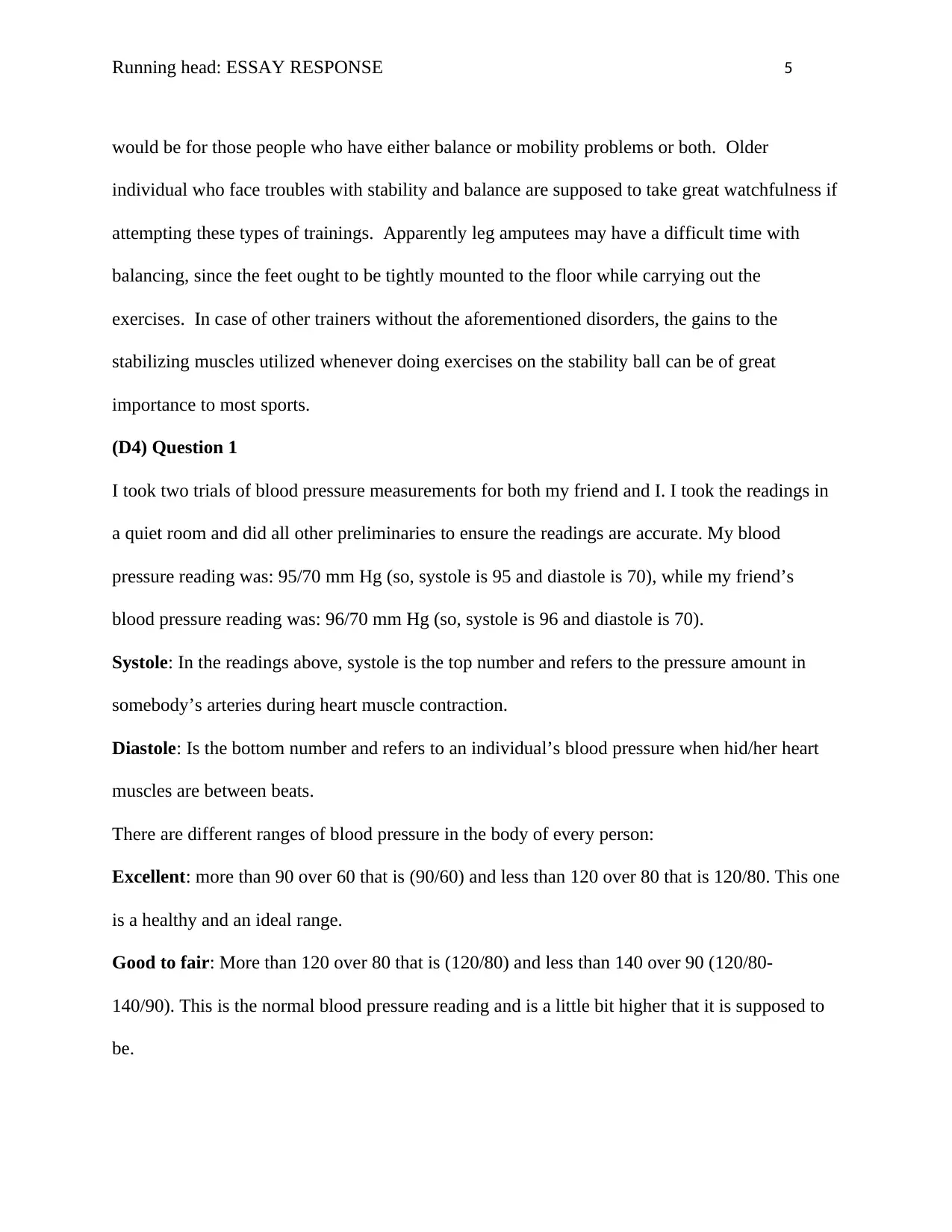
Running head: ESSAY RESPONSE 5
would be for those people who have either balance or mobility problems or both. Older
individual who face troubles with stability and balance are supposed to take great watchfulness if
attempting these types of trainings. Apparently leg amputees may have a difficult time with
balancing, since the feet ought to be tightly mounted to the floor while carrying out the
exercises. In case of other trainers without the aforementioned disorders, the gains to the
stabilizing muscles utilized whenever doing exercises on the stability ball can be of great
importance to most sports.
(D4) Question 1
I took two trials of blood pressure measurements for both my friend and I. I took the readings in
a quiet room and did all other preliminaries to ensure the readings are accurate. My blood
pressure reading was: 95/70 mm Hg (so, systole is 95 and diastole is 70), while my friend’s
blood pressure reading was: 96/70 mm Hg (so, systole is 96 and diastole is 70).
Systole: In the readings above, systole is the top number and refers to the pressure amount in
somebody’s arteries during heart muscle contraction.
Diastole: Is the bottom number and refers to an individual’s blood pressure when hid/her heart
muscles are between beats.
There are different ranges of blood pressure in the body of every person:
Excellent: more than 90 over 60 that is (90/60) and less than 120 over 80 that is 120/80. This one
is a healthy and an ideal range.
Good to fair: More than 120 over 80 that is (120/80) and less than 140 over 90 (120/80-
140/90). This is the normal blood pressure reading and is a little bit higher that it is supposed to
be.
would be for those people who have either balance or mobility problems or both. Older
individual who face troubles with stability and balance are supposed to take great watchfulness if
attempting these types of trainings. Apparently leg amputees may have a difficult time with
balancing, since the feet ought to be tightly mounted to the floor while carrying out the
exercises. In case of other trainers without the aforementioned disorders, the gains to the
stabilizing muscles utilized whenever doing exercises on the stability ball can be of great
importance to most sports.
(D4) Question 1
I took two trials of blood pressure measurements for both my friend and I. I took the readings in
a quiet room and did all other preliminaries to ensure the readings are accurate. My blood
pressure reading was: 95/70 mm Hg (so, systole is 95 and diastole is 70), while my friend’s
blood pressure reading was: 96/70 mm Hg (so, systole is 96 and diastole is 70).
Systole: In the readings above, systole is the top number and refers to the pressure amount in
somebody’s arteries during heart muscle contraction.
Diastole: Is the bottom number and refers to an individual’s blood pressure when hid/her heart
muscles are between beats.
There are different ranges of blood pressure in the body of every person:
Excellent: more than 90 over 60 that is (90/60) and less than 120 over 80 that is 120/80. This one
is a healthy and an ideal range.
Good to fair: More than 120 over 80 that is (120/80) and less than 140 over 90 (120/80-
140/90). This is the normal blood pressure reading and is a little bit higher that it is supposed to
be.

Running head: ESSAY RESPONSE 6
Poor: Poor blood pressure reads at 140/90 or even higher and it may be a sign of hypertension or
high blood pressure. So, somebody with this extreme blood pressure is advised to visit a doctor.
There are quite a number of correlations between an individual’s lifestyle and blood pressure.
The variety of activity levels and amount of stress can have a huge impact on a person’s blood
pressure. My friend’s and my blood pressure are very almost similar because we lead almost a
similar lifestyle. I shall use blood pressure as a starting point and a baseline for particular clients
who come to me with the hope of getting fit and lowering the levels of blood pressure.
(E4) Question
According to the recent science, intermittent fasting refers to a diet routine which rotates
between short periods of fasting, with either no food at all or substantial reduction of calorie, as
well as periods of unlimited eating. The individual who was on intermittent fasting experienced
several benefits such as simpler, more productive days, increased natural energy, better diet
decisions, reduced cravings, and was more focused in his activities. The other individual who
was on Paleo diet eating whole, unprocessed plant and animal foods was experiencing a drastic
lose of weight. His weight plateaued and then stabilized to what he assumed was his normal
weight. A gluten-free diet, on the other hand, involves consuming foodstuffs which contain the
protein gluten, such as barley, and wheat. The person I identified on this diet was experiencing
some weight-loss and also significant increase in energy levels. I am on Atkins diet wherein I am
consuming limited food choices but focusing on vegetables, protein, and fat. I am on weight-loss
program but unlike the three individuals I observed my rate of weight-loss is a little bit higher
since the decrease is noteworthy on daily basis. However, I noted we were all improving our
health by relying on these different diets. Out of the aforementioned diets, I would recommend
intermittent fasting to my client, which involves a process of cycling in and out of times of eating
Poor: Poor blood pressure reads at 140/90 or even higher and it may be a sign of hypertension or
high blood pressure. So, somebody with this extreme blood pressure is advised to visit a doctor.
There are quite a number of correlations between an individual’s lifestyle and blood pressure.
The variety of activity levels and amount of stress can have a huge impact on a person’s blood
pressure. My friend’s and my blood pressure are very almost similar because we lead almost a
similar lifestyle. I shall use blood pressure as a starting point and a baseline for particular clients
who come to me with the hope of getting fit and lowering the levels of blood pressure.
(E4) Question
According to the recent science, intermittent fasting refers to a diet routine which rotates
between short periods of fasting, with either no food at all or substantial reduction of calorie, as
well as periods of unlimited eating. The individual who was on intermittent fasting experienced
several benefits such as simpler, more productive days, increased natural energy, better diet
decisions, reduced cravings, and was more focused in his activities. The other individual who
was on Paleo diet eating whole, unprocessed plant and animal foods was experiencing a drastic
lose of weight. His weight plateaued and then stabilized to what he assumed was his normal
weight. A gluten-free diet, on the other hand, involves consuming foodstuffs which contain the
protein gluten, such as barley, and wheat. The person I identified on this diet was experiencing
some weight-loss and also significant increase in energy levels. I am on Atkins diet wherein I am
consuming limited food choices but focusing on vegetables, protein, and fat. I am on weight-loss
program but unlike the three individuals I observed my rate of weight-loss is a little bit higher
since the decrease is noteworthy on daily basis. However, I noted we were all improving our
health by relying on these different diets. Out of the aforementioned diets, I would recommend
intermittent fasting to my client, which involves a process of cycling in and out of times of eating
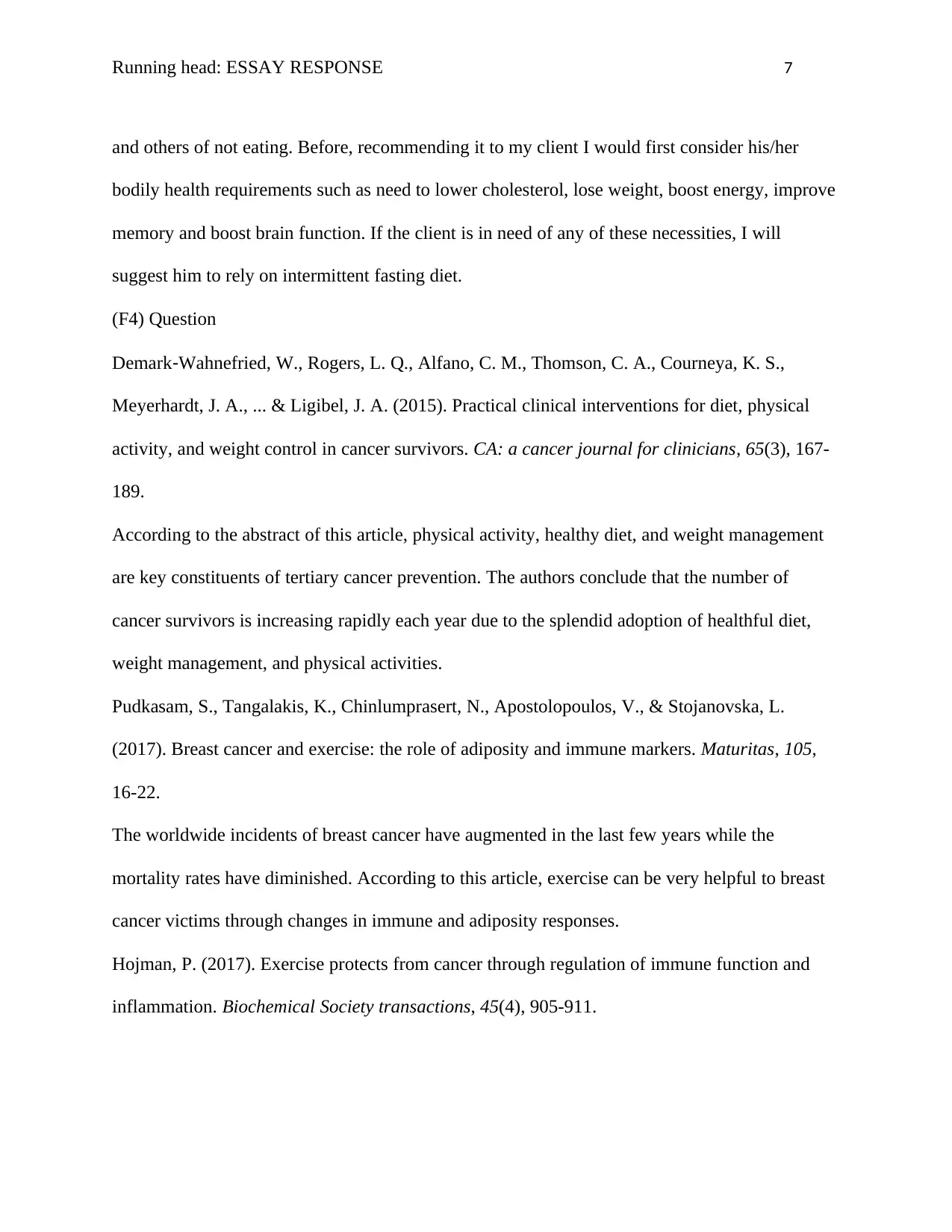
Running head: ESSAY RESPONSE 7
and others of not eating. Before, recommending it to my client I would first consider his/her
bodily health requirements such as need to lower cholesterol, lose weight, boost energy, improve
memory and boost brain function. If the client is in need of any of these necessities, I will
suggest him to rely on intermittent fasting diet.
(F4) Question
Demark‐Wahnefried, W., Rogers, L. Q., Alfano, C. M., Thomson, C. A., Courneya, K. S.,
Meyerhardt, J. A., ... & Ligibel, J. A. (2015). Practical clinical interventions for diet, physical
activity, and weight control in cancer survivors. CA: a cancer journal for clinicians, 65(3), 167-
189.
According to the abstract of this article, physical activity, healthy diet, and weight management
are key constituents of tertiary cancer prevention. The authors conclude that the number of
cancer survivors is increasing rapidly each year due to the splendid adoption of healthful diet,
weight management, and physical activities.
Pudkasam, S., Tangalakis, K., Chinlumprasert, N., Apostolopoulos, V., & Stojanovska, L.
(2017). Breast cancer and exercise: the role of adiposity and immune markers. Maturitas, 105,
16-22.
The worldwide incidents of breast cancer have augmented in the last few years while the
mortality rates have diminished. According to this article, exercise can be very helpful to breast
cancer victims through changes in immune and adiposity responses.
Hojman, P. (2017). Exercise protects from cancer through regulation of immune function and
inflammation. Biochemical Society transactions, 45(4), 905-911.
and others of not eating. Before, recommending it to my client I would first consider his/her
bodily health requirements such as need to lower cholesterol, lose weight, boost energy, improve
memory and boost brain function. If the client is in need of any of these necessities, I will
suggest him to rely on intermittent fasting diet.
(F4) Question
Demark‐Wahnefried, W., Rogers, L. Q., Alfano, C. M., Thomson, C. A., Courneya, K. S.,
Meyerhardt, J. A., ... & Ligibel, J. A. (2015). Practical clinical interventions for diet, physical
activity, and weight control in cancer survivors. CA: a cancer journal for clinicians, 65(3), 167-
189.
According to the abstract of this article, physical activity, healthy diet, and weight management
are key constituents of tertiary cancer prevention. The authors conclude that the number of
cancer survivors is increasing rapidly each year due to the splendid adoption of healthful diet,
weight management, and physical activities.
Pudkasam, S., Tangalakis, K., Chinlumprasert, N., Apostolopoulos, V., & Stojanovska, L.
(2017). Breast cancer and exercise: the role of adiposity and immune markers. Maturitas, 105,
16-22.
The worldwide incidents of breast cancer have augmented in the last few years while the
mortality rates have diminished. According to this article, exercise can be very helpful to breast
cancer victims through changes in immune and adiposity responses.
Hojman, P. (2017). Exercise protects from cancer through regulation of immune function and
inflammation. Biochemical Society transactions, 45(4), 905-911.
Paraphrase This Document
Need a fresh take? Get an instant paraphrase of this document with our AI Paraphraser
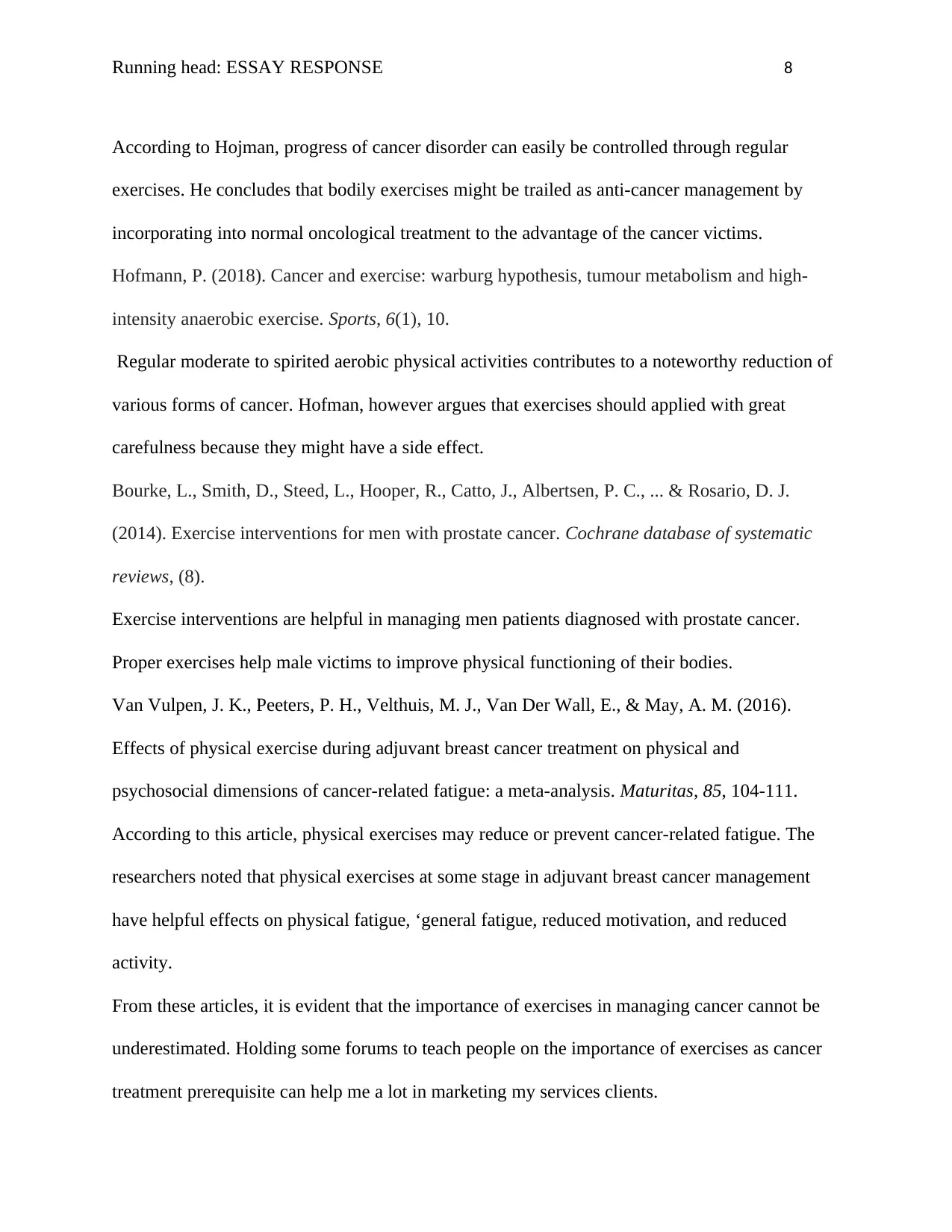
Running head: ESSAY RESPONSE 8
According to Hojman, progress of cancer disorder can easily be controlled through regular
exercises. He concludes that bodily exercises might be trailed as anti-cancer management by
incorporating into normal oncological treatment to the advantage of the cancer victims.
Hofmann, P. (2018). Cancer and exercise: warburg hypothesis, tumour metabolism and high-
intensity anaerobic exercise. Sports, 6(1), 10.
Regular moderate to spirited aerobic physical activities contributes to a noteworthy reduction of
various forms of cancer. Hofman, however argues that exercises should applied with great
carefulness because they might have a side effect.
Bourke, L., Smith, D., Steed, L., Hooper, R., Catto, J., Albertsen, P. C., ... & Rosario, D. J.
(2014). Exercise interventions for men with prostate cancer. Cochrane database of systematic
reviews, (8).
Exercise interventions are helpful in managing men patients diagnosed with prostate cancer.
Proper exercises help male victims to improve physical functioning of their bodies.
Van Vulpen, J. K., Peeters, P. H., Velthuis, M. J., Van Der Wall, E., & May, A. M. (2016).
Effects of physical exercise during adjuvant breast cancer treatment on physical and
psychosocial dimensions of cancer-related fatigue: a meta-analysis. Maturitas, 85, 104-111.
According to this article, physical exercises may reduce or prevent cancer-related fatigue. The
researchers noted that physical exercises at some stage in adjuvant breast cancer management
have helpful effects on physical fatigue, ‘general fatigue, reduced motivation, and reduced
activity.
From these articles, it is evident that the importance of exercises in managing cancer cannot be
underestimated. Holding some forums to teach people on the importance of exercises as cancer
treatment prerequisite can help me a lot in marketing my services clients.
According to Hojman, progress of cancer disorder can easily be controlled through regular
exercises. He concludes that bodily exercises might be trailed as anti-cancer management by
incorporating into normal oncological treatment to the advantage of the cancer victims.
Hofmann, P. (2018). Cancer and exercise: warburg hypothesis, tumour metabolism and high-
intensity anaerobic exercise. Sports, 6(1), 10.
Regular moderate to spirited aerobic physical activities contributes to a noteworthy reduction of
various forms of cancer. Hofman, however argues that exercises should applied with great
carefulness because they might have a side effect.
Bourke, L., Smith, D., Steed, L., Hooper, R., Catto, J., Albertsen, P. C., ... & Rosario, D. J.
(2014). Exercise interventions for men with prostate cancer. Cochrane database of systematic
reviews, (8).
Exercise interventions are helpful in managing men patients diagnosed with prostate cancer.
Proper exercises help male victims to improve physical functioning of their bodies.
Van Vulpen, J. K., Peeters, P. H., Velthuis, M. J., Van Der Wall, E., & May, A. M. (2016).
Effects of physical exercise during adjuvant breast cancer treatment on physical and
psychosocial dimensions of cancer-related fatigue: a meta-analysis. Maturitas, 85, 104-111.
According to this article, physical exercises may reduce or prevent cancer-related fatigue. The
researchers noted that physical exercises at some stage in adjuvant breast cancer management
have helpful effects on physical fatigue, ‘general fatigue, reduced motivation, and reduced
activity.
From these articles, it is evident that the importance of exercises in managing cancer cannot be
underestimated. Holding some forums to teach people on the importance of exercises as cancer
treatment prerequisite can help me a lot in marketing my services clients.

Running head: ESSAY RESPONSE 9
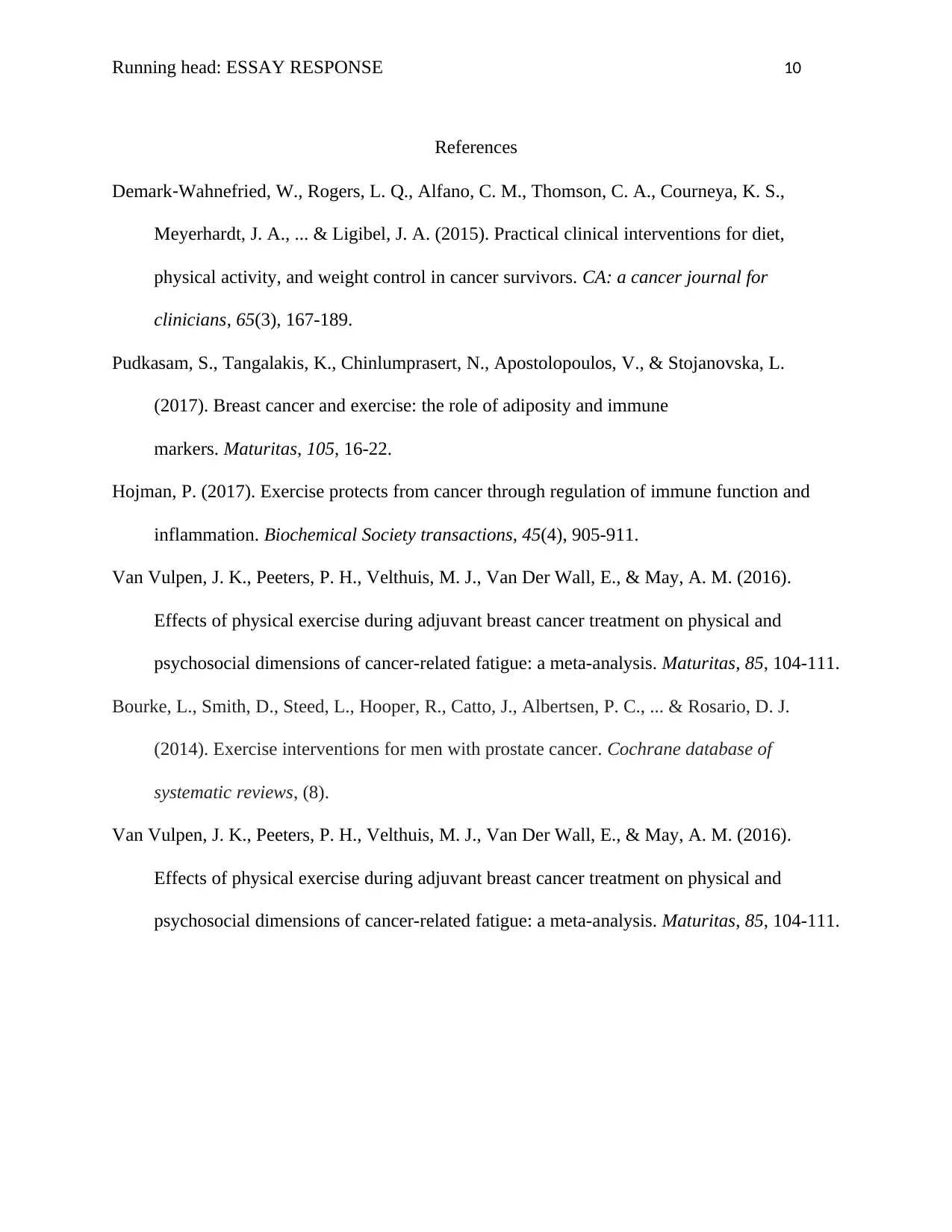
Running head: ESSAY RESPONSE 10
References
Demark‐Wahnefried, W., Rogers, L. Q., Alfano, C. M., Thomson, C. A., Courneya, K. S.,
Meyerhardt, J. A., ... & Ligibel, J. A. (2015). Practical clinical interventions for diet,
physical activity, and weight control in cancer survivors. CA: a cancer journal for
clinicians, 65(3), 167-189.
Pudkasam, S., Tangalakis, K., Chinlumprasert, N., Apostolopoulos, V., & Stojanovska, L.
(2017). Breast cancer and exercise: the role of adiposity and immune
markers. Maturitas, 105, 16-22.
Hojman, P. (2017). Exercise protects from cancer through regulation of immune function and
inflammation. Biochemical Society transactions, 45(4), 905-911.
Van Vulpen, J. K., Peeters, P. H., Velthuis, M. J., Van Der Wall, E., & May, A. M. (2016).
Effects of physical exercise during adjuvant breast cancer treatment on physical and
psychosocial dimensions of cancer-related fatigue: a meta-analysis. Maturitas, 85, 104-111.
Bourke, L., Smith, D., Steed, L., Hooper, R., Catto, J., Albertsen, P. C., ... & Rosario, D. J.
(2014). Exercise interventions for men with prostate cancer. Cochrane database of
systematic reviews, (8).
Van Vulpen, J. K., Peeters, P. H., Velthuis, M. J., Van Der Wall, E., & May, A. M. (2016).
Effects of physical exercise during adjuvant breast cancer treatment on physical and
psychosocial dimensions of cancer-related fatigue: a meta-analysis. Maturitas, 85, 104-111.
References
Demark‐Wahnefried, W., Rogers, L. Q., Alfano, C. M., Thomson, C. A., Courneya, K. S.,
Meyerhardt, J. A., ... & Ligibel, J. A. (2015). Practical clinical interventions for diet,
physical activity, and weight control in cancer survivors. CA: a cancer journal for
clinicians, 65(3), 167-189.
Pudkasam, S., Tangalakis, K., Chinlumprasert, N., Apostolopoulos, V., & Stojanovska, L.
(2017). Breast cancer and exercise: the role of adiposity and immune
markers. Maturitas, 105, 16-22.
Hojman, P. (2017). Exercise protects from cancer through regulation of immune function and
inflammation. Biochemical Society transactions, 45(4), 905-911.
Van Vulpen, J. K., Peeters, P. H., Velthuis, M. J., Van Der Wall, E., & May, A. M. (2016).
Effects of physical exercise during adjuvant breast cancer treatment on physical and
psychosocial dimensions of cancer-related fatigue: a meta-analysis. Maturitas, 85, 104-111.
Bourke, L., Smith, D., Steed, L., Hooper, R., Catto, J., Albertsen, P. C., ... & Rosario, D. J.
(2014). Exercise interventions for men with prostate cancer. Cochrane database of
systematic reviews, (8).
Van Vulpen, J. K., Peeters, P. H., Velthuis, M. J., Van Der Wall, E., & May, A. M. (2016).
Effects of physical exercise during adjuvant breast cancer treatment on physical and
psychosocial dimensions of cancer-related fatigue: a meta-analysis. Maturitas, 85, 104-111.
1 out of 10
Your All-in-One AI-Powered Toolkit for Academic Success.
+13062052269
info@desklib.com
Available 24*7 on WhatsApp / Email
![[object Object]](/_next/static/media/star-bottom.7253800d.svg)
Unlock your academic potential
© 2024 | Zucol Services PVT LTD | All rights reserved.
